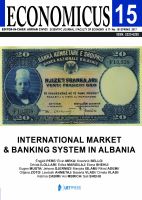Trade barriers: Theory and applications
Trade barriers: Theory and applications
Author(s): Besarta VLADI, Ornela VladiSubject(s): Supranational / Global Economy, International relations/trade, Financial Markets
Published by: Shtëpia botuese “UET Press”
Keywords: International trade; Protectionism; Trade barriers; Tariffs; Subsidies;
Summary/Abstract: Globalization’s acceleration since the mid-1980s was driven by two key indicators: technological advances and increasing liberalization of trade. The end of the 2nd World War marked the beginning of a multi-dimensional cooperation in international level. Especially more and more governments started to recognize the crucial importance of international trade and decided gradually to remove their protectionist policies and open their economies towards foreign competition. International institutions such as World Bank, International Monetary Fund (IMF), General Agreement on Tariffs and Trade (GATT) or World Trade Organization (WTO) play a very important role in promoting free trade and facilitating international flow of goods and capital. Democratic systems tend to employ lower trade barriers compared to other governmental systems. In addition, globalization wave has especially removed borders and facilitated international trade. Nonetheless, time has shown that implementing free trade is almost a perfect condition which is hard to be achieved. Countries, for several internal and external reasons, decide to employ trade obstacles. This paper aims to examine most common trade barriers and presents several case studies on barrier confirmed notifications.
Journal: ECONOMICUS
- Issue Year: 15/2017
- Issue No: 1
- Page Range: 135-148
- Page Count: 14
- Language: English

